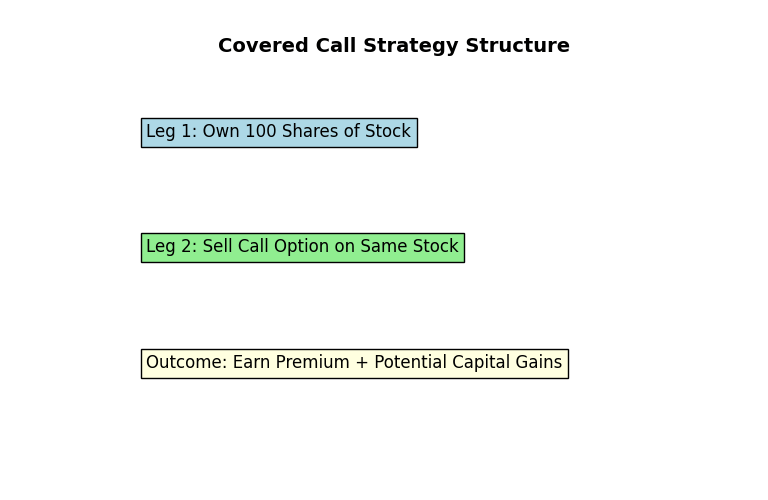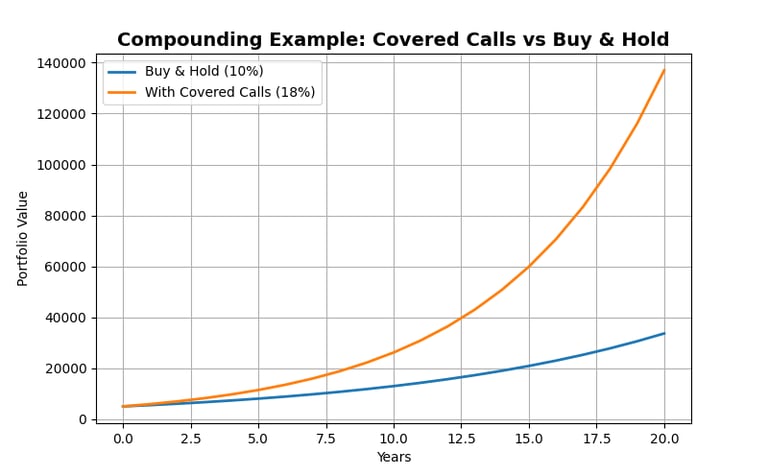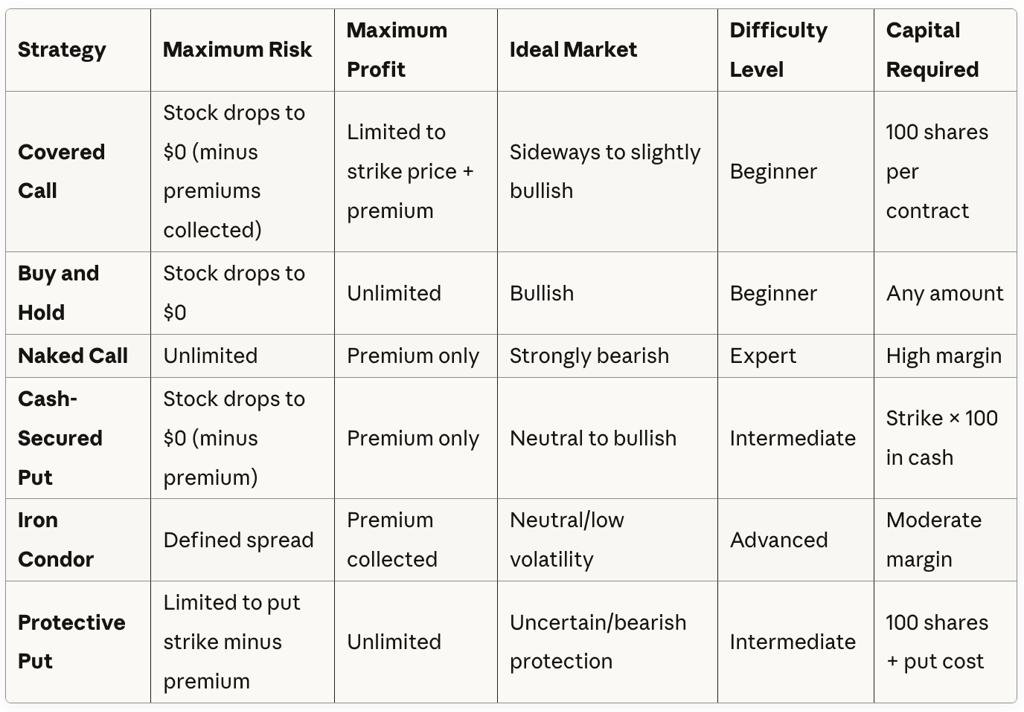Covered Call Strategy: Generate Monthly Income from Stocks
Discover how the covered call strategy can turn your stock portfolio into a reliable source of monthly income. Learn how to reduce risk, lower your cost basis, and profit in sideways markets using this low-risk options technique.
OPTIONS TRADING
Ben T.
10/6/202511 min read


Covered Call Strategy: How to Earn Monthly Income from Stocks You Already Own
Learn the covered call options strategy for beginners to generate monthly income from stocks. Low-risk options trading that creates cash flow even in sideways markets. Real examples included.
What Is a Covered Call Strategy?
A covered call is a conservative options strategy where an investor holds a stock and sells a call option on that stock to generate income. It’s ideal for long-term investors seeking monthly cash flow, especially in sideways or mildly bullish markets.
The Hidden Rental Income: Master the Covered Call Strategy to Collect Steady Monthly Cash Flow on Your Stock Portfolio
As an experienced options guru, I know that many new investors shy away from options, often viewing them as overly complicated or excessively risky. This is a massive mistake. When used intelligently, options are powerful tools that reduce risk and provide opportunities for accelerated, consistent income.
Among the various options strategies available, none are more essential for the prudent investor than the Covered Call (CC). This low-risk options trading strategy is so safe, straightforward, and effective that it is often referred to as a risk-free way to collect "rental income" every single month on stocks you already own.
If you own stocks merely hoping for capital gains while ignoring cash flow opportunities, you are leaving money on the table. Imagine buying a piece of property and letting it sit idle, waiting for appreciation, instead of monetizing it immediately through rent. Covered calls for beginners offer this same real estate philosophy, allowing you to generate income with options from assets you already possess.
Here is your blueprint to mastering the covered call options strategy and turning your stagnant stocks into productive income machines.


1. The Covered Call Imperative: Why Cash Flow Trumps Capital Gains
Traditionally, investors focus solely on capital gains, waiting for a stock's price to rise before selling for a profit. This forces profits to remain "unrealized" until the sale actually occurs.
However, the current financial landscape, characterized by persistently low interest rates and increasing inflation, has diminished the value of traditional savings accounts and Certificates of Deposit (CDs). Savings accounts are now likened to "depletion accounts" as inflation erodes the real value of cash.
This environment makes generating cash flow essential. The covered call options strategy offers an alternative: a safe and simple way to generate steady monthly income from stocks that helps overcome low interest rates and inflation. By receiving cash flow, you gain the opportunity to reinvest those funds, leveraging your investments without taking on debt.
Why Monthly Income from Stocks Matters:
Provides liquidity without selling your core holdings
Enables dollar-cost averaging into new positions
Creates a psychological advantage by seeing tangible returns monthly
Offers protection against market stagnation
2. Covered Call Mechanics 101: Building the Risk-Proof Trade
The covered call strategy is an entry-level approach with a high success rate. Unlike riskier options plays, covered calls are entirely safe if executed correctly. This simplicity is why most brokers allow you to execute CCs with a standard cash account and only require a Level 1 options trading account, the easiest type to qualify for.
A covered call is a two-legged strategy that transforms the inherent risk of selling an option into a protected position.
Leg 1: The Long Stock Position
The first leg is the foundational piece: you must own at least 100 shares of the underlying stock for every one options contract you plan to write. We recommend initiating covered calls on stock positions that already have an ample profit cushion (unrealized gains) built in.
Leg 2: The Short Call Option
The second leg involves writing (selling) a call option against those shares. Writing a call normally exposes the seller to unlimited risk, as a stock's price can theoretically rise indefinitely. However, because you hold the necessary 100 shares in your account, your position is "covered".
Premium Received: When you write the call, you immediately receive the option's price, known as the premium, in your brokerage account. You keep this cash no matter what happens to the stock.
Assignment (The Obligation): The options buyer has the right, but not the obligation, to exercise the option. Conversely, as the writer, you have no choice if the buyer chooses to exercise the option (an event called assignment).
Risk Mitigation: If the option moves "In The Money" (ITM) and you are assigned, your broker simply sells your already-owned 100 shares to the buyer at the predetermined strike price. This means your downside risk is always defined, and you eliminate the catastrophic risk associated with writing a "naked call" (a call sold without owning the underlying stock).
Real-World Example: Covered Call on Apple (AAPL)
Let's walk through a practical example to illustrate how to generate income with options using Apple stock:
Initial Position:
You own 100 shares of AAPL purchased at $170 per share
Current stock price: $180 per share (you have $1,000 unrealized profit)
Date: 30 days before expiration
The Trade:
You sell (write) 1 call option contract with a $185 strike price
Expiration: 35 days out
Premium received: $2.50 per share = $250 cash (immediately credited to your account)
Delta: 0.35 (35% probability of finishing ITM)
Three Possible Outcomes:
Scenario 1 - Stock Stays Below $185 (Most Common)
Option expires worthless
You keep your 100 shares + the $250 premium
Annualized return from premium alone: ~26%
You can immediately write another covered call
Scenario 2 - Stock Rises Above $185 (Assignment)
Your shares are called away at $185
Total profit: $1,500 capital gain + $250 premium = $1,750
Annualized return on original investment: ~61%
You can repurchase shares or move to another stock
Scenario 3 - Stock Drops Below $170 (Downside Protection)
Option expires worthless, you keep the $250 premium
Your effective cost basis is now $167.50 ($170 - $2.50)
The premium provides a 1.47% buffer against losses
You still own the shares and can write another call
This example demonstrates how covered calls for beginners create income in multiple market conditions while limiting downside risk.
3. The Power of the Synthetic Dividend and Compounding
The primary attraction of the covered call options strategy is the creation of a synthetic dividend—an external source of cash flow that supplements or replaces traditional dividends.
Exponential Growth through Compounding
Generating this cash flow significantly accelerates your long-term wealth accumulation through compounding. For instance, if you earn an 8% annualized yield from your covered calls (far exceeding typical dividend yields) and reinvest those proceeds, your growth can drastically outperform a pure buy-and-hold approach.
A $5,000 investment growing at 10% annually for 20 years would yield $30,580. However, if that same investment generates an additional 8% annually from covered calls, which is then compounded, the final amount could jump to $116,072—a 279% increase in capital.
Reducing Your Cost Basis
Every premium you collect directly reduces your cost basis (the effective purchase price) in the underlying stock.
If you bought a stock for $80 per share and consistently earn 8% in annual premiums, your effective purchase price is reduced by $6.40 (or 8% of $80) each year. This cushion allows you to withstand larger capital losses in a down market because your effective purchase price is much lower. Furthermore, this reduction increases your unrealized capital gains.
Monthly Income from Stocks Calculation:
100 shares at $80 = $8,000 investment
8% annual premium = $640 per year
Monthly income = approximately $53 per month per position
With 10 positions = $530 monthly passive income
4. Selecting Ideal Stocks and Market Conditions
The covered call options strategy works best when the underlying stock is moving sideways (ranging) or only slightly upward, as this minimizes the risk of the stock being called away due to a sudden massive appreciation.
Stable Candidates Over "Hot" Stocks
You must resist the urge to write calls on volatile, high-growth companies that attract many speculators, such as Tesla or high-flying tech stocks. When these stocks surge, the opportunity cost of having your profit capped is substantial.
Instead, look for stable, boring companies with predictable, gently rising profits and revenues. Ideal candidates are often:
Established Companies: Look for large or mega-cap companies with a history of stability, such as those that pay reliable dividends. Examples include Johnson & Johnson (JNJ), Procter & Gamble (PG), Coca-Cola (KO), and Microsoft (MSFT).
Low Volatility: Seek stocks trading at implied volatility (IV) levels between 30% and 70%. IV measures how forcefully the market expects the stock to move. Too low, and premiums won't be worth your time; too high, and assignment risk increases.
Sideways Movement: Use technical indicators like the Choppiness Index or the Average Directional Index (ADX) to confirm the stock is trading in a tight, non-trending range. An ADX below 25 typically indicates a ranging market.
Dividend Aristocrats: Companies with 25+ years of consecutive dividend increases often make excellent covered call candidates due to their stability and existing income stream.
If you are a long-term investor, your primary goal is to prioritize holding onto the stock at all costs, using covered calls only as a "little boost" to your gains.
5. Mastering the Trade: Strike Prices, Expiry, and the Greeks
Successful covered call writing involves precision timing guided by two crucial Greek variables: Delta and Theta.
The Role of Delta (Δ) in Strike Selection
Delta is the most important Greek for covered call writers. It is used as a proxy to determine the probability that an option will finish ITM.
For Income (Short-Term Bias): If you are looking for higher premiums and are comfortable risking the stock being called away, you should aim for strikes with a Delta close to 0.4 (40%). A Delta of 0.426, for example, suggests a 42.6% chance of the option finishing ITM.
For Stock Preservation (Long-Term Bias): If your goal is to generate income with options while almost guaranteeing you keep the stock, choose a strike price that is far Out-of-the-Money (OTM), meaning a Delta as close to 0.0 as possible. A Delta between 0.10 and 0.20 is ideal for this approach.
Leveraging Time Decay (Theta Θ)
As an option seller/writer, time decay (Theta) is your ally. Theta measures how much the option premium loses value each day it approaches expiry.
Critically, time decay is not linear; it accelerates once the option moves within 30 days of expiry. Therefore, the optimal time frame for writing covered calls is the 30-45 day window. This period captures sufficient time value built into the premium while positioning you to benefit from the accelerating decay as the option nears expiration.
Time Decay Sweet Spot:
Days 45-30: Moderate decay, building premium
Days 30-15: Accelerated decay, optimal profit zone
Days 15-0: Maximum decay, highest risk of assignment if ITM
Exit Strategy: The Art of the Roll
Your best-case scenario is for the option to expire worthless (OTM), allowing you to keep the premium and the stock. If the stock price rises and your short call nears the strike price, you should consider implementing an exit strategy.
You can buy back the call option for a lower price (due to time decay) to realize profit and remove the assignment risk. You can then "roll out" or "roll forward" by immediately writing a new option with a further expiry date, thereby continuously lowering the cost basis of your stock holding and generating new income.
Rolling Example:
Original call: $185 strike, expires in 5 days, now trading at $0.50
Buy to close at $0.50 (you originally sold for $2.50 = $2.00 profit locked in)
Sell new call: $190 strike, expires in 35 days, collect $2.80
Net result: Extended time, raised strike, collected additional premium


Risk Comparison: Covered Calls vs. Other Strategies
Understanding where covered calls fit in the risk spectrum helps beginners appreciate their unique advantages.
Key Insight: Covered calls offer the best risk-reward balance for investors who already own stocks and want to generate monthly income from stocks without significantly increasing portfolio risk.


Advanced Tips for Maximizing Returns
1. The "Wheel Strategy" Connection
Once you master covered calls, you can evolve into the Wheel Strategy, which combines cash-secured puts with covered calls to generate income whether you own the stock or not.
2. Earnings Announcement Timing
Avoid writing covered calls immediately before earnings announcements, as volatility spikes can lead to rapid price movements and assignment risk. However, premiums are higher during these periods if you're comfortable with the risk.
3. Tax Considerations
Premiums from covered calls are taxed as short-term capital gains. If your shares are called away before meeting the one-year holding period, your stock gains also become short-term. Plan accordingly for tax efficiency.
4. Portfolio Allocation
Don't write covered calls on your entire portfolio. Reserve 30-50% of holdings for pure capital appreciation opportunities while using 50-70% for income generation.
5. The 50% Profit Rule
Many successful traders buy back their covered calls when they've captured 50% of the premium value, even with time remaining. This allows you to re-write new calls and compound faster.
Frequently Asked Questions (Covered Call Strategy)
What happens if my stock gets called away?
If your stock is called away (assigned), your broker automatically sells your 100 shares at the strike price. You keep both the premium you collected and any capital gains up to the strike price. This is actually a profitable outcome—you simply reached your maximum profit potential on that trade. You can then use the proceeds to either buy back the shares (if you still like the stock) or deploy capital elsewhere.
Can I write covered calls in my IRA or 401(k)?
Yes, most brokerage firms allow covered calls in retirement accounts because they're considered low-risk options trading strategies. You'll typically need to apply for Level 1 options approval, which is the easiest level to obtain. Check with your specific broker for their requirements.
How much money can I realistically make with covered calls?
Conservative covered call strategies typically generate 6-12% annual returns from premiums alone, on top of any stock appreciation or dividends. More aggressive approaches (selling closer to the money) can yield 15-25% annually but with higher assignment risk. Your actual returns depend on stock selection, strike prices chosen, and market conditions.
What's the minimum account size needed to start?
Since you need 100 shares per contract, your minimum investment depends on share price. A $50 stock requires $5,000, while a $200 stock needs $20,000. However, many investors start with fractional positions or use lower-priced quality stocks to begin learning the covered call options strategy with less capital.
Should I write covered calls on dividend stocks?
Yes, dividend-paying stocks are often ideal for covered calls for beginners because they provide dual income streams (dividends + premiums). Just ensure you don't write calls that expire before ex-dividend dates if preserving dividend income is important to you, as assignment before the ex-dividend date means the buyer receives the dividend.
What if the stock drops significantly after I sell a covered call?
The premium you collected provides a small buffer against losses, reducing your effective cost basis. However, covered calls don't protect against major downturns—you'll still experience losses if the stock falls significantly. The strategy works best on quality stocks you're comfortable holding long-term. Consider combining covered calls with stop-losses or protective puts if downside protection is a priority.
How do I choose between monthly and weekly covered calls?
Monthly options (30-45 days) are generally recommended for most investors because they offer better premium-to-risk ratios and require less active management. Weekly options can generate higher annualized returns but demand constant monitoring and more frequent trading decisions. Beginners should start with monthly cycles and graduate to weekly options only after gaining experience.
Can I write multiple covered call contracts on the same stock?
Yes, if you own 300 shares, you can write up to 3 call contracts. However, all contracts written in a single trade typically share the same strike and expiration. This approach scales your income but also scales your assignment risk proportionally.
Conclusion: An Intelligent Tool for Steady Wealth
The covered call options strategy is a powerful instrument that converts your buy-and-hold investments into an active stream of income. It is not a get-rich-quick scheme, but a disciplined, passive strategy that requires minor maintenance. By using covered calls to generate income with options on investments you already own, you accelerate your compounding, reduce your cost basis, and ensure you make money even when the market is going nowhere.
When used smartly and in moderation, options transform from a gambling tool to an intelligent investor's best friend. Focus on stability, select OTM strikes based on delta, and leverage the power of time decay to set yourself up for long-term financial success.
Whether you're seeking monthly income from stocks to supplement retirement, building wealth through compounding, or simply maximizing returns on existing holdings, the covered call strategy offers a proven, low-risk options trading approach that works in multiple market environments.
Start small, master the mechanics, and gradually scale your income-generating positions. The rental income from your stock portfolio awaits—it's time to collect what's rightfully yours.
Note: Need a reliable well-known broker to trade options: Try TeastyTrade


